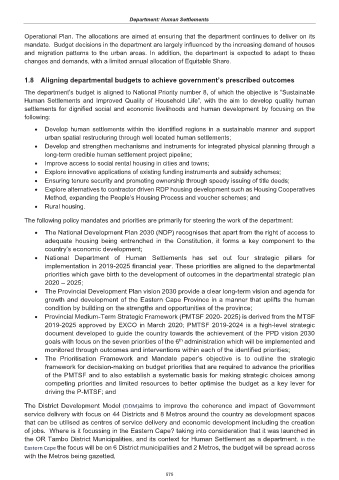Page 592 - Provincial Treasury Estimates.pdf
P. 592
Department: +XPDQ 6HWWOHPHQWV
Operational Plan. The allocations are aimed at ensuring that the department continues to deliver on its
mandate. Budget decisions in the department are largely influenced by the increasing demand of houses
and migration patterns to the urban areas. In addition, the department is expected to adapt to these
changes and demands, with a limited annual allocation of Equitable Share.
1.8 Aligning departmental budgets to achieve government’s prescribed outcomes
The department’s budget is aligned to National Priority number 8, of which the objective is “Sustainable
Human Settlements and Improved Quality of Household Life”, with the aim to develop quality human
settlements for dignified social and economic livelihoods and human development by focusing on the
following:
x Develop human settlements within the identified regions in a sustainable manner and support
urban spatial restructuring through well located human settlements;
x Develop and strengthen mechanisms and instruments for integrated physical planning through a
long-term credible human settlement project pipeline;
x Improve access to social rental housing in cities and towns;
x Explore innovative applications of existing funding instruments and subsidy schemes;
x Ensuring tenure security and promoting ownership through speedy issuing of title deeds;
x Explore alternatives to contractor driven RDP housing development such as Housing Cooperatives
Method, expanding the People’s Housing Process and voucher schemes; and
x Rural housing.
The following policy mandates and priorities are primarily for steering the work of the department:
x The National Development Plan 2030 (NDP) recognises that apart from the right of access to
adequate housing being entrenched in the Constitution, it forms a key component to the
country’s economic development;
x National Department of Human Settlements has set out four strategic pillars for
implementation in 2019-2025 financial year. These priorities are aligned to the departmental
priorities which gave birth to the development of outcomes in the departmental strategic plan
2020 – 2025;
x The Provincial Development Plan vision 2030 provide a clear long-term vision and agenda for
growth and development of the Eastern Cape Province in a manner that uplifts the human
condition by building on the strengths and opportunities of the province;
x Provincial Medium-Term Strategic Framework (PMTSF 2020- 2025) is derived from the MTSF
2019-2025 approved by EXCO in March 2020; PMTSF 2019-2024 is a high-level strategic
document developed to guide the country towards the achievement of the PPD vision 2030
goals with focus on the seven priorities of the 6 administration which will be implemented and
th
monitored through outcomes and interventions within each of the identified priorities;
x The Prioritisation Framework and Mandate paper’s objective is to outline the strategic
framework for decision-making on budget priorities that are required to advance the priorities
of the PMTSF and to also establish a systematic basis for making strategic choices among
competing priorities and limited resources to better optimise the budget as a key lever for
driving the P-MTSF; and
The District Development Model (DDM)aims to improve the coherence and impact of Government
service delivery with focus on 44 Districts and 8 Metros around the country as development spaces
that can be utilised as centres of service delivery and economic development including the creation
of jobs. Where is it focussing in the Eastern Cape? taking into consideration that it was launched in
the OR Tambo District Municipalities, and its context for Human Settlement as a department. In the
Eastern Cape the focus will be on 6 District municipalities and 2 Metros, the budget will be spread across
with the Metros being gazetted,
575

